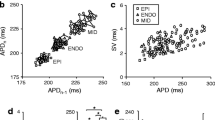Abstract
There is currently some uncertainty about whether cardiac pacemaker cells contain tetrodotoxin (TTX)-sensitive Na+ channels although TTX is known to slow heart rate. We have recorded transient and persistent single-channel currents activated by depolarization in myocytes isolated from the toad sinus venosus. The myocytes were identified as pacemaker cells by their characteristic morphology, spontaneous action potentials that were blocked by cobalt but not by TTX, and lack of an inwardly rectifying K+ current. The voltage dependence of the single-channel currents, their presence in solutions containing no K+ or Ca2+, or in solutions to which Cs+ and Co2+ had been added, their dependence on [Na+] and their sensitivity to TTX indicated that they were Na+ channel currents. The persistent Na+ channel currents were resistant to inactivation and were activated over the range of potentials that occur during diastole in pacemaker cells: they would therefore contribute to the pacemaker current that sets heart rate. It was concluded that TTX slows heart rate by blocking these channels in pacemaker cells.
Similar content being viewed by others
References
Bristow DG, Clark JW Jr (1983) A mathematical model of the vagally driven primary pacemaker. Am J Physiol 244: H150-H161
Brown AM, Lee KS, Powell T (1981) Sodium current in single rat heart muscle cells. J Physiol (Lond) 318:479–500
Brown HF, Kimura J, Noble D, Noble SJ, Taupignon A (1984) The slow inward current, isi, in the rabbit sinoatrial node investigated by voltage clamp and computer simulation. Proc R Soc Lond [Biol] 222:305–328
Bywater RAR, Campbell G, Edwards FR, Hirst GDS, O’Shea JE (1989) The effects of vagal stimulation and applied acetylcholine on the sinus venosus of the toad. J Physiol (Lond) 415:35–56
Campbell DL, Rasmusson RL, Strauss HC (1992) Ionic current mechanisms generating vertebrate primary cardiac pacemaker activity at the single cell level: an integrative view. Annu Rev Physiol 54:279–302
Denyer JC, Brown HF (1990) Rabbit sino-atral node cells: isolation and electrophysiological properties. J Physiol (Lond) 428:405–424
Giles WR, Shibata EF (1985) Voltage clamp of bull-frog cardiac pacemaker cells: A quantitative analysis of potassium currents. J Physiol (Lond) 368:265–292
Giles WR, Ginneken ACG van, Shibata EF (1986) Ionic currents underlying pacemaker activity: a summary of voltage clamp data from single cells. In: Nathan RD(ed) Cardiac muscle: The regulation of exitation and contraction. Academic Press, Orland, pp 1–27
Hagiwara N, Irisawa H, Kasanuki H, Hosoda S (1992) Background current in sino-atrial node cells of the rabbit heart. J Physiol (Lond) 448:53–72
Hamill OP, Marty A, Neher E, Sakmann B, Sigworth FJ (1981) Improved patch-clamp techniques for high resolution current recording from cells and cell-free membrane patches. Pflügers Arch 391:85–100
Horn R, Marty A (1988) Muscarinic activation of ionic currents measured by a new whole-cell recording method. J Gen Physiol 92:145–159
IrisawaH, Giles W (1990) Sinus and atrioventricular node cell: cellular electrophysiology. In: Zipes D, Jalife J (eds) Cardiac electrophysiology: from cell to bed-side Saunders, Philadelphia, pp 95–102
Irisawa H, Brown HF, Giles W (1993) Cardiac pacemaking in the sinoatrial node. Physiol Rev 73:197–227
Isenberg G, Klöckner U (1982) Calcium-tolerant ventricular myocytes prepared by preincubation in a “KB medium”. Pflügers Arch 395:6–18
Ju Y-K, Saint DA, Gage PW (1994) Inactivation-resistant channels underlying the persistent sodium current in rat ventricular myocytes. Proc R Soc Lond [Biol] 256:163–168
Ju YK, Saint DA, Hirst GDS, Gage PW (1995) Sodium currents in toad cardiac pacemaker cells. J Membr Biol 145: 119–128
Kiyosue T, Spindler AJ, Noble SJ, Noble D (1993) Background inward current in ventricular and atrial cells of the guinea-pig. Proc R Soc Lond [Biol] 252:65–74
Kreitner D (1975) Evidence for the existence of a rapid sodium channel in the membrane of rabbit sinoatrial cells. J Mol Cell Cardiol 7:655–662
Levitan ES, Kramer R (1990) Neuropeptide modulation of single calcium and potassium channels detected with a new patch clamp configuration. Nature 348:545–547
Noble D, Noble SJ (1984) A model of sino-atrial node electrical activity based on a modification of the DiFrancesco-Noble (1984) equations. Proc R Soc Lond [Biol] 222:295–304
Noble D, DiFrancesco D, Denyer J (1989) Ionic mechanisms in normal and abnormal cardiac pacemaking activity. In: Jacklet JW (ed) Neuronal and cellular oscillators. Dekker, New York, p 59
Patlak JB, Ortiz M (1985) Slow currents through single sodium channels of the adult rat heart. J Gen Physiol 86:89–104
Rae J, Cooper K, Gates P, Watsky M (1991) Low access resistance perforated patch recordings using amphotericin B. J Neurosci Methods 37:15–26
Rasmusson RL, Clark JW, Giles WR, Shibata EF, Campbell DL (1990) A mathematical model of a bullfrog cardiac pacemaker cell. Am J Physiol 259:H352-H369
Saint DA, Ju YK, Gage PW (1992) A persistent sodium current in rat ventricular myocytes. J Physiol (Lond) 453: 219–231
Wilders R, Jongsma HJ, Ginneken AC van (1991) Pacemaker activity of the rabbit sinoatrial node. A comparison of mathematical models. Biophys J 60:1202–1216
Yamagishi S, Sano T (1966) Effect of tetrodotoxin on the pacemaker action potential of sinus node. Proc Jap Acad 42: 1194–1196
Author information
Authors and Affiliations
Rights and permissions
About this article
Cite this article
Ju, Y.K., Saint, D.A. & Gage, P.W. Tetrodotoxin-sensitive inactivation-resistant sodium channels in pacemaker cells influence heart rate. Pflügers Arch. 431, 868–875 (1996). https://doi.org/10.1007/s004240050079
Received:
Revised:
Accepted:
Issue Date:
DOI: https://doi.org/10.1007/s004240050079




